Acoustic Anomalies and Fast Relaxation Dynamics of Amorphous Progesterone as Revealed by Brillouin Light Scattering
Abstract
:1. Introduction
2. Results
2.1. Brillouin Scattering Spectrum
2.2. Analysis and Comparison
3. Discussion
4. Materials and Methods
4.1. Materials
4.2. Methods
5. Conclusions
Acknowledgments
Author Contributions
Conflicts of Interest
References
- Hancock, B.C.; Zograf, G. Characteristics and Significance of the Amorphous State in Pharmaceutical Systems. J. Pharm. Sci. 1997, 86, 1–12. [Google Scholar] [CrossRef] [PubMed]
- Descamps, M. Disordered Pharmaceutical Materials, 1st ed.; Wiley-VCH: Weinheim, Germany, 2016; ISBN 978-3-527-33125-3. [Google Scholar]
- Johari, G.P.; Pyke, D. On the glassy and supercooled liquid states of a common medicament: Aspirin. Phys. Chem. Chem. Phys. 2000, 2, 5479–5484. [Google Scholar] [CrossRef]
- Dyre, J.C. The glass transition and elastic models of glass-forming liquids. Rev. Mod. Phys. 2006, 78, 953–972. [Google Scholar] [CrossRef]
- Kothari, K.; Ragoonanan, V.; Suryanarayanan, R. Influence of Molecular Mobility on the Physical Stability of Amorphous Pharmaceuticals in the Supercooled and Glassy States. Mol. Pharm. 2014, 11, 3048–3055. [Google Scholar] [CrossRef] [PubMed]
- Johari, G.P.; Kim, S.; Shanker, R.M. Dielectric Relaxation and Crystallization of Ultraviscous Melt and Glassy States of Aspirin, Ibuprofen, Progesterone, and Quinidine. J. Pharm. Sci. 2007, 96, 1159–1175. [Google Scholar] [CrossRef] [PubMed]
- Johari, G.P.; Kim, S.; Shanker, R.M. Dielectric Study of Equimolar Acetaminophen–Aspirin, Acetaminophen–Quinidine, and Benzoic Acid–Progesterone Molecular Alloys in the Glass and Ultraviscous States and Their Relevance to Solubility and Stability. J. Pharm. Sci. 2010, 99, 1358–1374. [Google Scholar] [CrossRef] [PubMed]
- Campsteyn, H.; Dupont, L.; Dideberg, O. Structure Cristalline et Moléculaire de la Progestérone, C21H30O2. Acta Crystallogr. Sect. B 1972, 28, 3032–3042. [Google Scholar] [CrossRef]
- Foresti, S.E.; Krajewski, A.; Mongiorgi, R.; Riva de Sanseverino, L.; Cameroni, R. 4-Pregnen-3,20-Dione (Progesterone, Form 2). Cryst. Struct. Commun. 1975, 4, 189–192. [Google Scholar]
- Payne, R.S.; Roberts, R.J.; Rowe, R.C.; Docherty, R. Examples of successful crystal structure prediction: Polymorphs of primidone and progesterone. Int. J. Pharm. 1999, 177, 231–245. [Google Scholar] [CrossRef]
- Narayana Kalkura, S.; Devanarayanan, S. Growth of progesterone crystals in silica gel and their characterization. J. Mater. Sci. Lett. 1988, 7, 827–829. [Google Scholar] [CrossRef]
- Wang, F.; Wachter, J.A.; Antosz, F.J.; Berglund, K.A. An investigation of solvent mediated polymorphic transformation of progesterone using in situ Raman spectroscopy. Org. Process Res. Dev. 2000, 4, 391–395. [Google Scholar] [CrossRef]
- Cendejas-Santana, G.; Hinojosa-Torres, J.; Gastaño, V.M. Progesterone crystallization from a solvent: A new procedure. Mater. Res. Innovat. 2002, 6, 252–255. [Google Scholar] [CrossRef]
- Falcon, J.A.; Berglund, K.A. In situ monitoring of antisolvent addition crystallization with principal components analysis of Raman spectra. Cryst. Growth Des. 2004, 4, 457–463. [Google Scholar] [CrossRef]
- Lancaster, R.W.; Karamertzanis, P.G.; Hulme, A.T.; Tocher, D.A.; Lewis, T.C.; Price, S.L. The polymorphism of progesterone: Stabilization of a ‘disappearing’ polymorph by co-crystallization. J. Pharm. Sci. 2007, 96, 3419–3431. [Google Scholar] [CrossRef] [PubMed]
- Comez, L.; Masciovecchio, C.; Monaco, G.; Fioretto, D. Progress in liquid and glass physics by Brillouin scattering spectroscopy. Solid Stat Phys. 2012, 63, 1–77. [Google Scholar]
- Ko, J.-H.; Lee, K.-S.; Ike, Y.; Kojima, S. Elastic properties of aspirin in its crystalline and glassy phases studied by micro-Brillouin scattering. Chem. Phys. Lett. 2008, 465, 36–39. [Google Scholar] [CrossRef]
- Kim, T.H.; Ko, J.-H.; Lee, K.-S.; Ike, Y.; Kojima, S. Growth of Aspirin Single Crystals and the Temperature Dependence of Its Elastic Constants As Studied by Brillouin Scattering. New Phys. Sae Mulli 2009, 58, 596–601. [Google Scholar]
- Ko, J.-H.; Kim, T.H.; Lee, K.-S.; Kojima, S. Acoustic properties of aspirin in its various phases and transformation stages studied by Brillouin scattering. J. Non-Cryst. Solids 2011, 357, 547–551. [Google Scholar] [CrossRef]
- Ko, J.-H.; Kim, T.H.; Lee, K.-S.; Kojima, S. Brillouin scattering study on crystalline and glassy states of anti-inflammatory racemic S(+)–R(−) ibuprofen. Chem. Phys. Lett. 2011, 515, 221–225. [Google Scholar] [CrossRef]
- Kim, T.H.; Shibata, T.; Kojima, S.; Shin, D.-M.; Hwang, Y.-H.; Ko, J.-H. Comparison of thermal and elastic properties of glassy racemic and enantiomorphic ibuprofen studied by Brillouin light scattering and modulated differential scanning calorimetry. Curr. Appl. Phys. 2014, 14, 965–969. [Google Scholar] [CrossRef]
- Shin, D.-M.; Hwang, Y.-H.; Ko, J.-H.; Kojima, S. Relaxation behaviors of enantiomorphic S-ibuprofen as revealed by dielectric and photon correlation spectroscopies. Curr. Appl. Phys. 2015, 15, 958–963. [Google Scholar] [CrossRef]
- Kwon, H.-J.; Kim, T.H.; Ko, J.-H.; Hwang, Y.-H. Relaxation phenomena in supercooled liquid and glassy acetaminophen studied by dielectric, photon correlation and Brillouin light scattering spectroscopies. Chem. Phys. Lett. 2013, 556, 117–121. [Google Scholar] [CrossRef]
- Kim, T.H.; Ko, J.-H.; Kwon, E.M.; Jun, J.-G. Micro-Brillouin Spectroscopy Applied to the Glass Transition of Anti-inflammatory Egonol. J. Opt. Soc. Korea 2010, 14, 403–408. [Google Scholar] [CrossRef]
- Ko, J.-H.; Kim, T.H.; Jung, S.H.; Jun, J.-G. Study on the Possibility of Vitrification and Phase Transition in Decursinol Studied by Using Brillouin Light Scattering. New Phys. Sae Mulli 2013, 63, 444–448. [Google Scholar]
- Shibata, T.; Takayama, H.; Kim, T.H.; Kojima, S. Acoustic and thermal anomalies in a liquid–glass transition of racemic S(+)–R(−) ketoprofen. Chem. Phys. Lett. 2014, 592, 80–84. [Google Scholar] [CrossRef] [Green Version]
- Vacher, R.; Boyer, L. Brillouin scattering: A tool for the measurement of elastic and photoelastic constants. Phys. Rev. B 1972, 6, 639–673. [Google Scholar] [CrossRef]
- Ko, J.-H.; Kim, D.H.; Kojima, S.; Kim, J.-H.; Choo, W.K. Brillouin Scattering Study on Polycrystalline Relaxor Ferroelectrics. Jpn. J. Appl. Phys. 2003, 42, 3076–3079. [Google Scholar] [CrossRef]
- Watanabe, A. A Trial Production of a Table of the Optical Crystallographic Characteristics of Crystalline Drugs Including Crystal Habits (Study of Crystalline Drugs by Means of a Polarizing Microscope. XIX. Yakugaku Zasshi 2002, 122, 595–606. [Google Scholar] [CrossRef] [PubMed]
- Torell, L.M. Brillouin scattering study of hypersonic relaxation in Ca(NO3)2-KNO3 mixture. J. Chem. Phys. 1982, 76, 3467–3473. [Google Scholar] [CrossRef]
- Kriegs, H.; Meier, G.; Gapinski, J.; Patkowski, A. The effect of intramolecular relaxations on the damping of longitudinal and transverse phonons in polysiloxanes studied by Brillouin spectroscopy. J. Chem. Phys. 2008, 128, 014507. [Google Scholar] [CrossRef] [PubMed] [Green Version]
- Fioretto, D.; Scarponi, F. Dynamics of a glassy polymer studied by Brillouin light scattering. Mater. Sci. Eng. A 2009, 521–522, 243–246. [Google Scholar] [CrossRef]
- Comez, L.; Pietrella, M.; Fioretto, D.; Monaco, G.; Scarponi, F.; Verbeni, R. Brillouin-scattering study of the fast dynamics of m-toluidine. Philos. Mag. 2007, 87, 651–656. [Google Scholar] [CrossRef]
- Schammé, B.; Mignot, M.; Couvrat, N.; Tognetti, V.; Joubert, L.; Dupray, V.; Delbreilh, L.; Dargent, E.; Coquerel, G. Molecular Relaxations in Supercooled Liquid and Glassy States of Amorphous Quinidine: Dielectric Spectroscopy and Density Functional Theory Approaches. J. Phys. Chem. B 2016, 120, 7579–7592. [Google Scholar] [CrossRef] [PubMed]
- Shikii, K.; Sakamoto, S.; Seki, H.; Utsumi, H.; Yamaguchi, K. Narcissistic aggregation of steroid compounds in diluted solution elucidated by CSI-MS, PFG NMR and X-ray analysis. Tetrahedron 2004, 60, 3487–3492. [Google Scholar] [CrossRef]
- Bryk, T.; Ruocco, G.; Scopigno, T.; Seitsonen, A.P. Pressure-induced emergence of unusually high-frequency transverse excitations in a liquid alkali metal: Evidence of two types of collective excitations contributing to the transverse dynamics at high pressures. J. Chem. Phys. 2015, 143, 104502. [Google Scholar] [CrossRef] [PubMed] [Green Version]
- Grzybowska, K.; Capaccioli, S.; Paluch, M. Recent developments in the experimental investigations of relaxations in pharmaceuticals by dielectric techniques at ambient and elevated pressure. Adv. Drug Deliv. Rev. 2016, 100, 158–182. [Google Scholar] [CrossRef] [PubMed]
- Ko, J.-H.; Jeong, M.-S.; Lee, B.W.; Kim, J.H.; Ko, Y.H.; Kim, K.J.; Kim, T.H.; Kojima, S.; Ahart, M. Pressure Dependence of Acoustic Properties of Liquid Ethanol by using High-pressure Brillouin Spectroscopy. Korean J. Opt. Photon. 2013, 24, 279–286. [Google Scholar] [CrossRef]
- Oh, S.H.; Cho, B.J.; Jeong, M.S.; Ko, J.-H. Evaluation of the isothermal curing process of UV-cured resin in terms of elasticity studied through micro-Brillouin light scattering. J. Inf. Disp. 2016, 17, 87–91. [Google Scholar] [CrossRef]

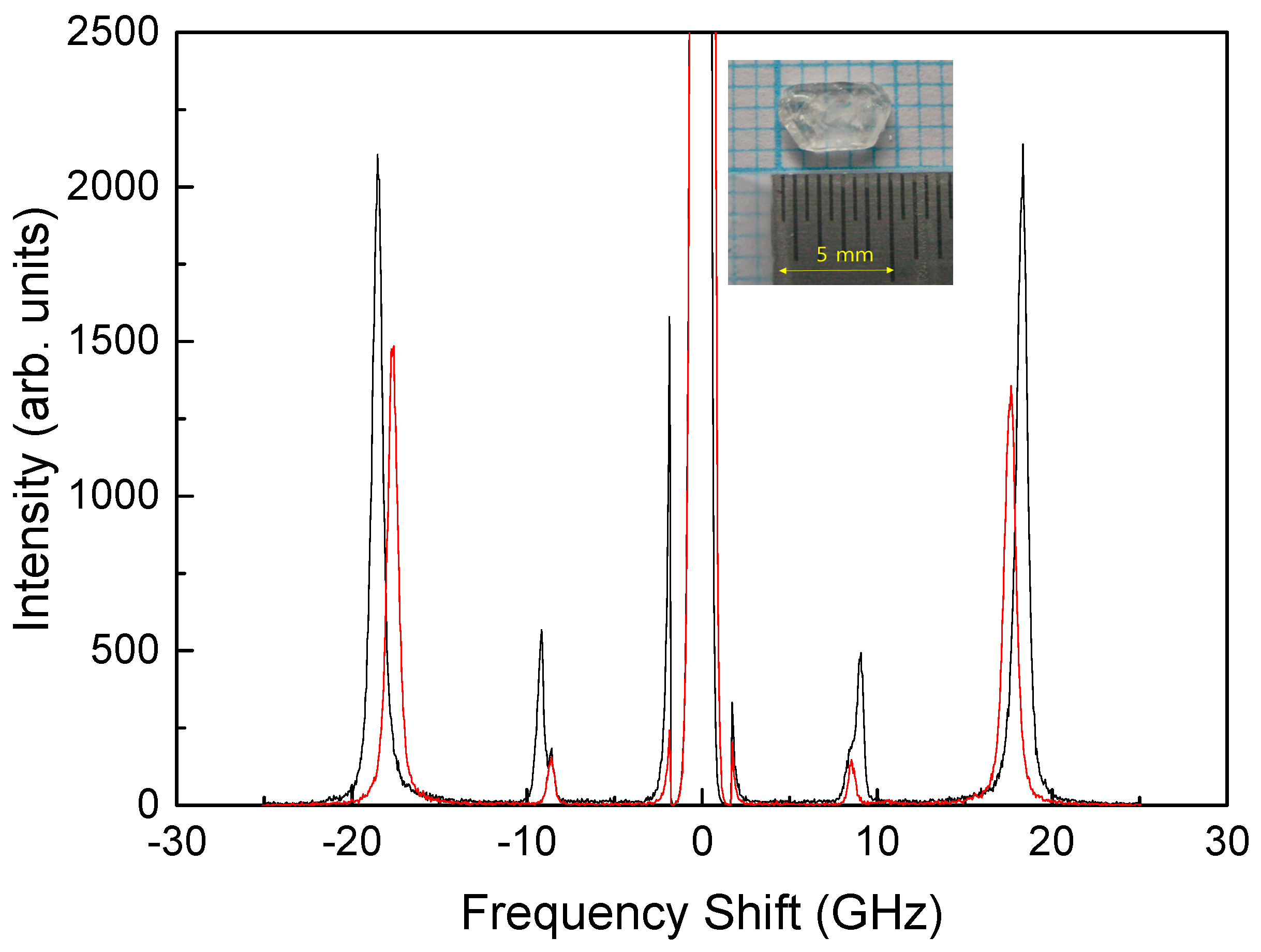
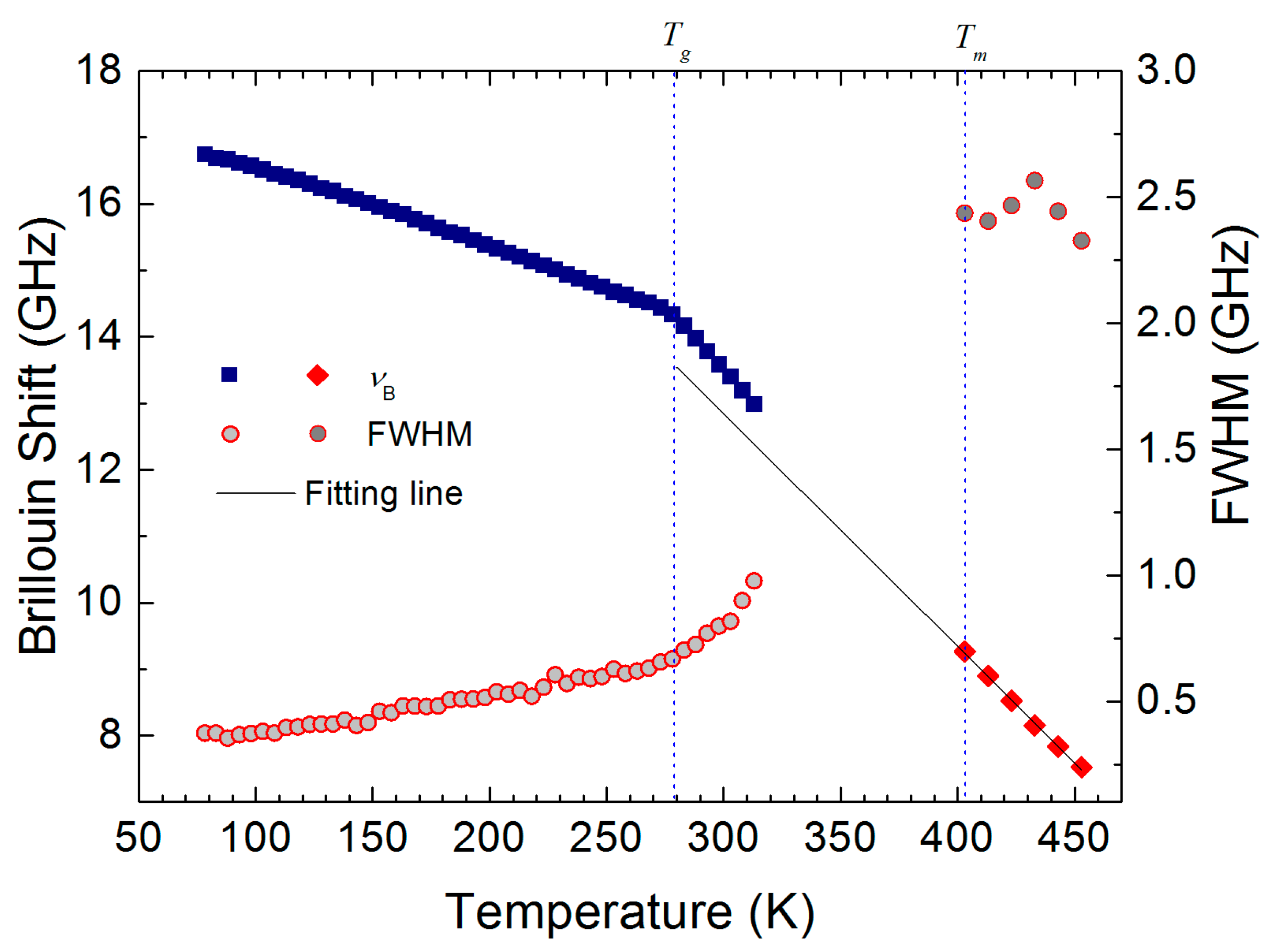

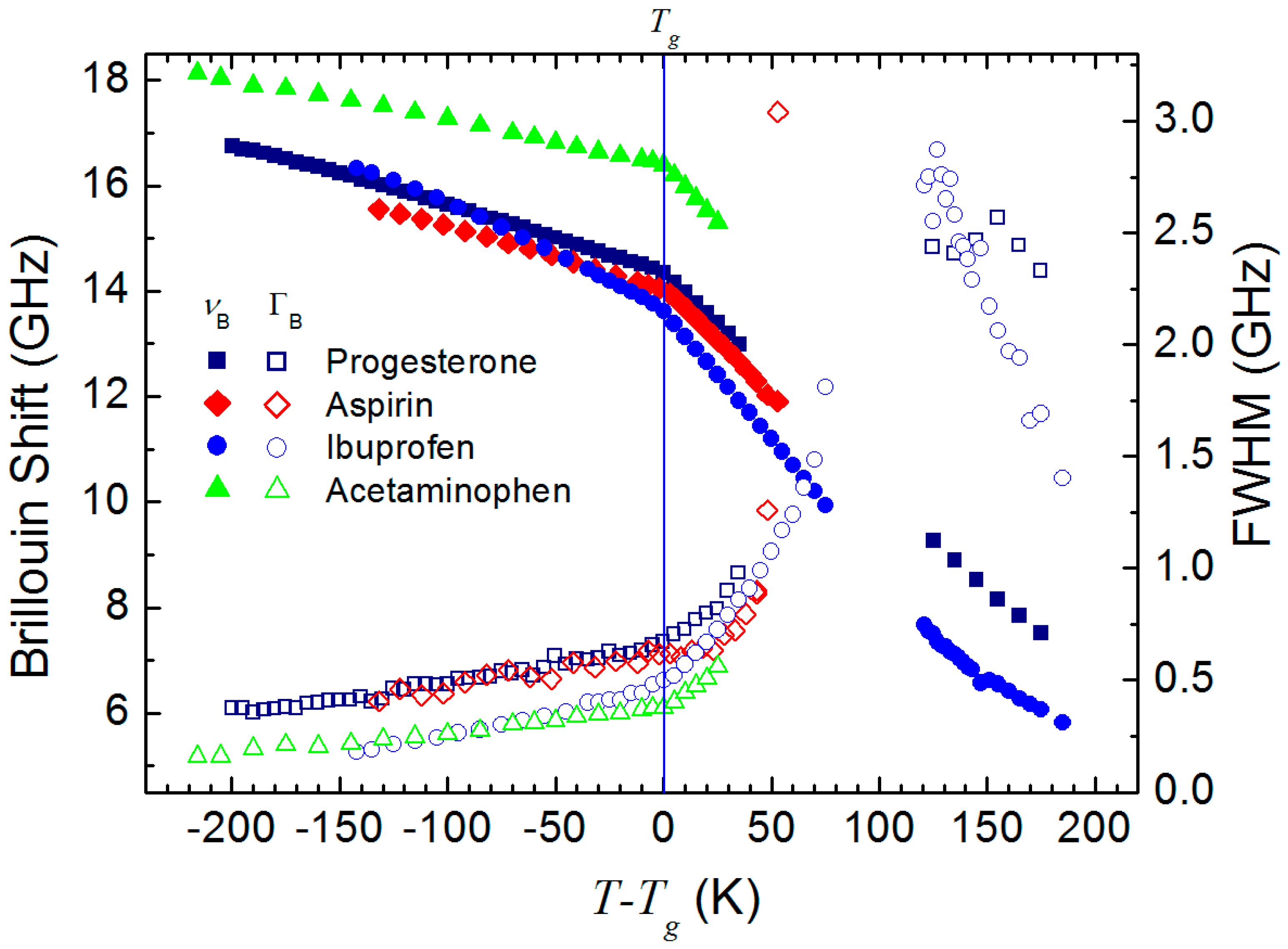
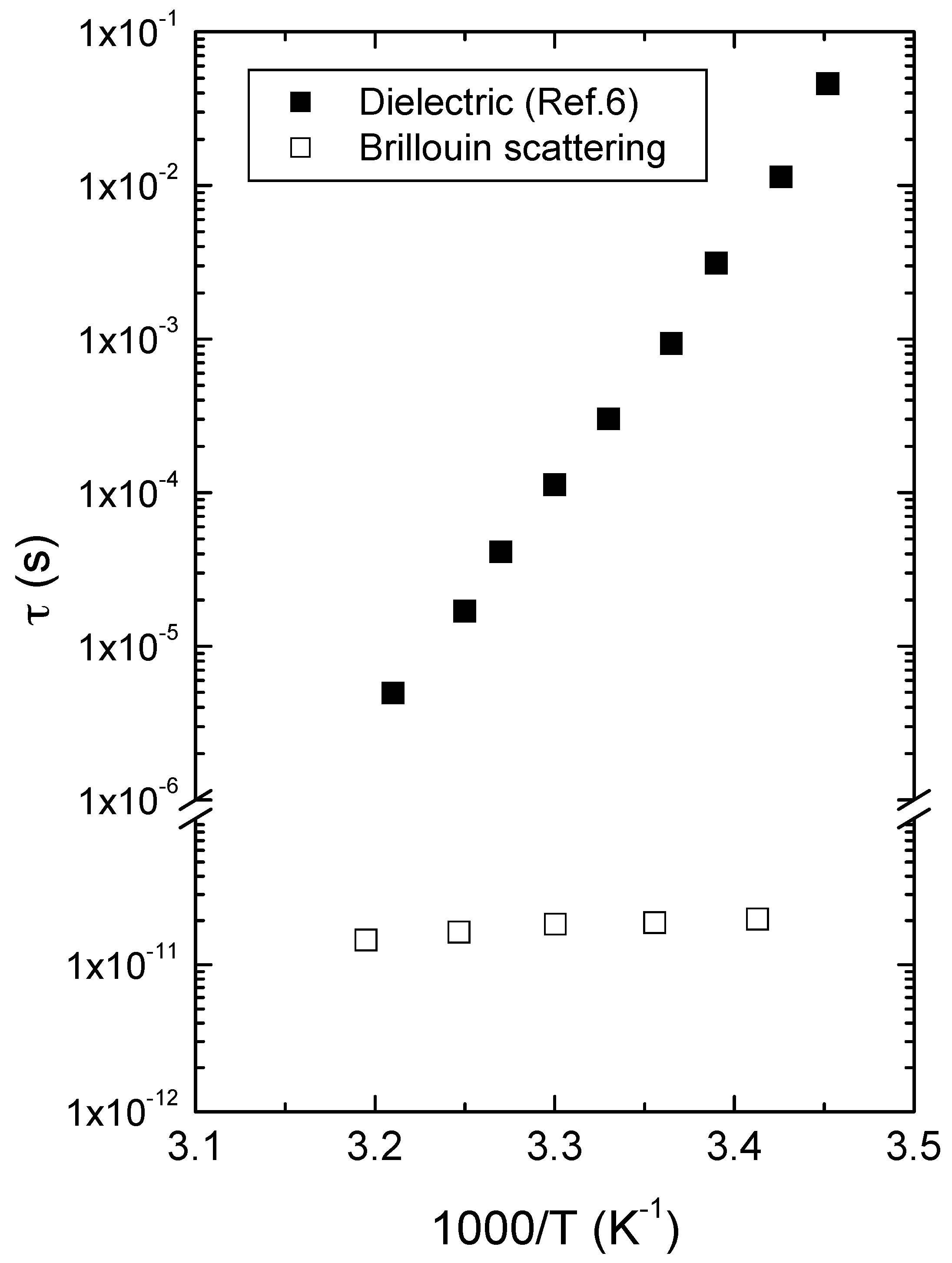
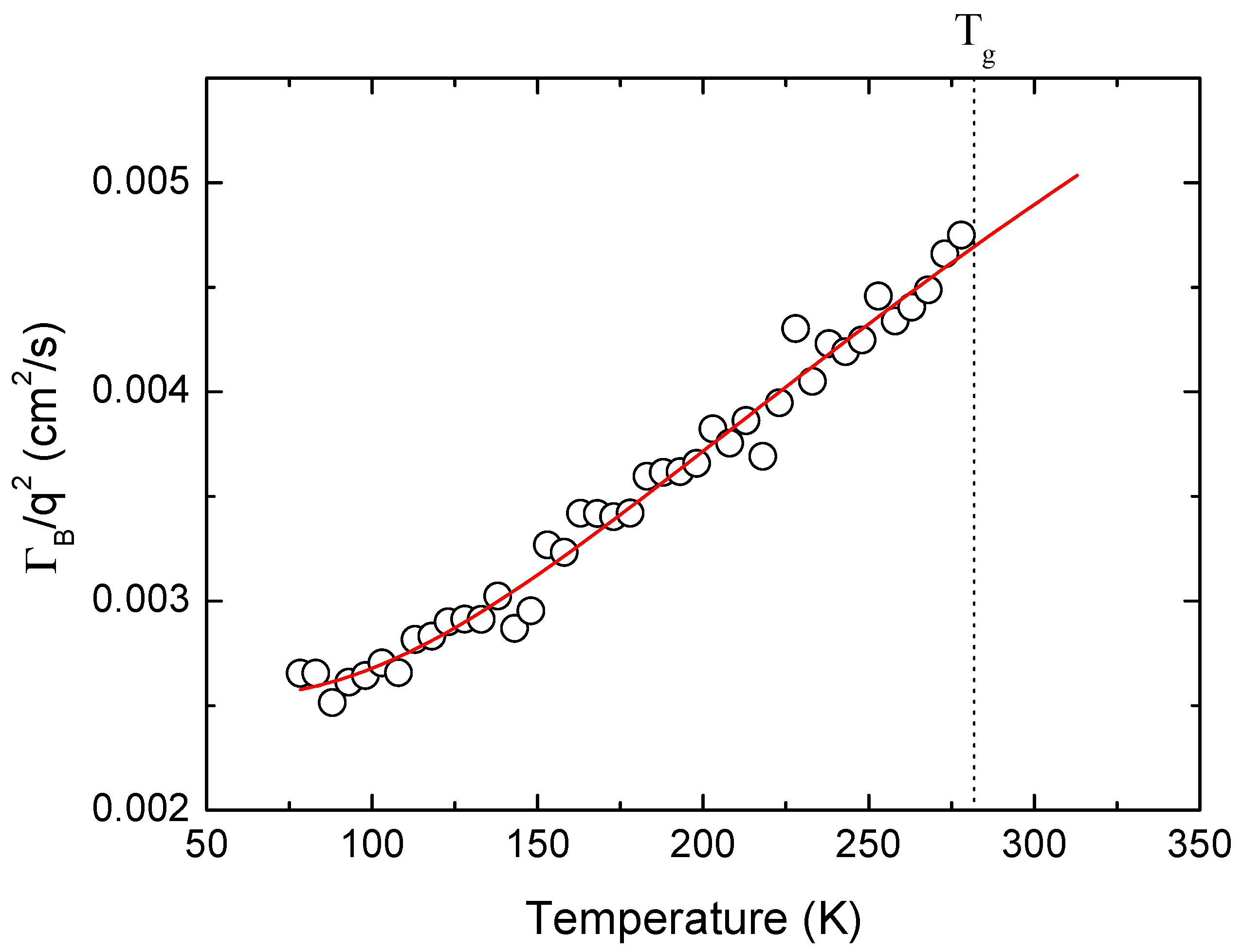
© 2017 by the authors. Licensee MDPI, Basel, Switzerland. This article is an open access article distributed under the terms and conditions of the Creative Commons Attribution (CC BY) license (http://creativecommons.org/licenses/by/4.0/).
Share and Cite
Kim, T.H.; Yoo, H.; Ko, J.-H. Acoustic Anomalies and Fast Relaxation Dynamics of Amorphous Progesterone as Revealed by Brillouin Light Scattering. Materials 2017, 10, 1426. https://doi.org/10.3390/ma10121426
Kim TH, Yoo H, Ko J-H. Acoustic Anomalies and Fast Relaxation Dynamics of Amorphous Progesterone as Revealed by Brillouin Light Scattering. Materials. 2017; 10(12):1426. https://doi.org/10.3390/ma10121426
Chicago/Turabian StyleKim, Tae Hyun, Hyojong Yoo, and Jae-Hyeon Ko. 2017. "Acoustic Anomalies and Fast Relaxation Dynamics of Amorphous Progesterone as Revealed by Brillouin Light Scattering" Materials 10, no. 12: 1426. https://doi.org/10.3390/ma10121426




